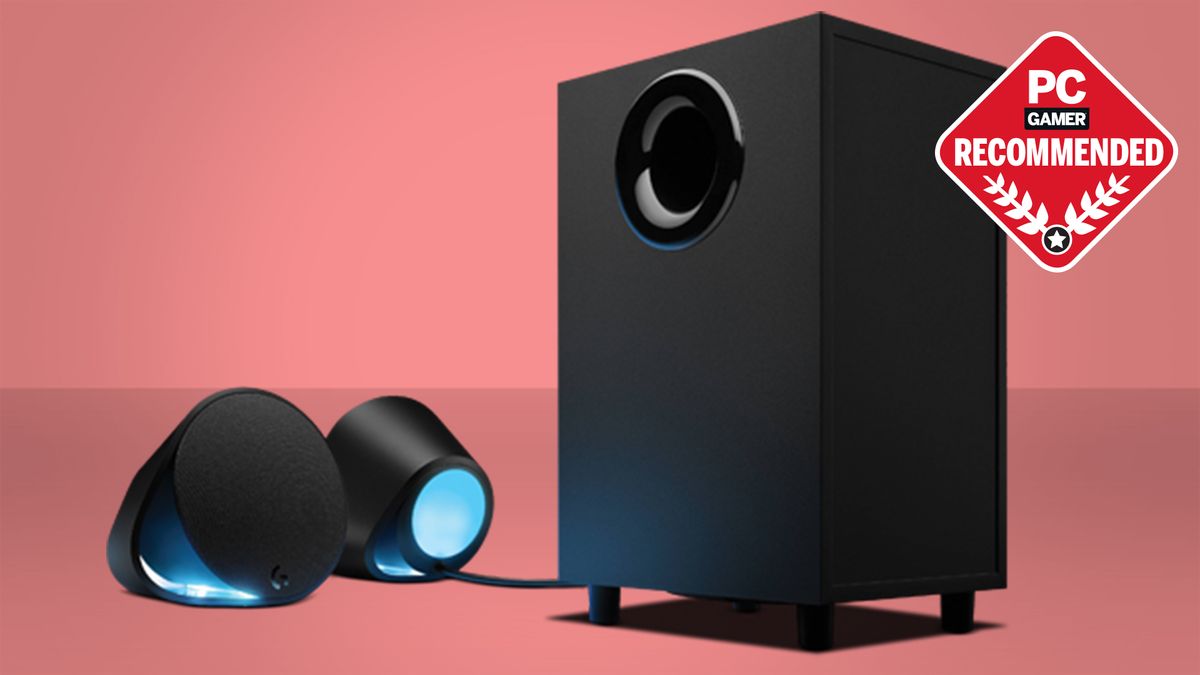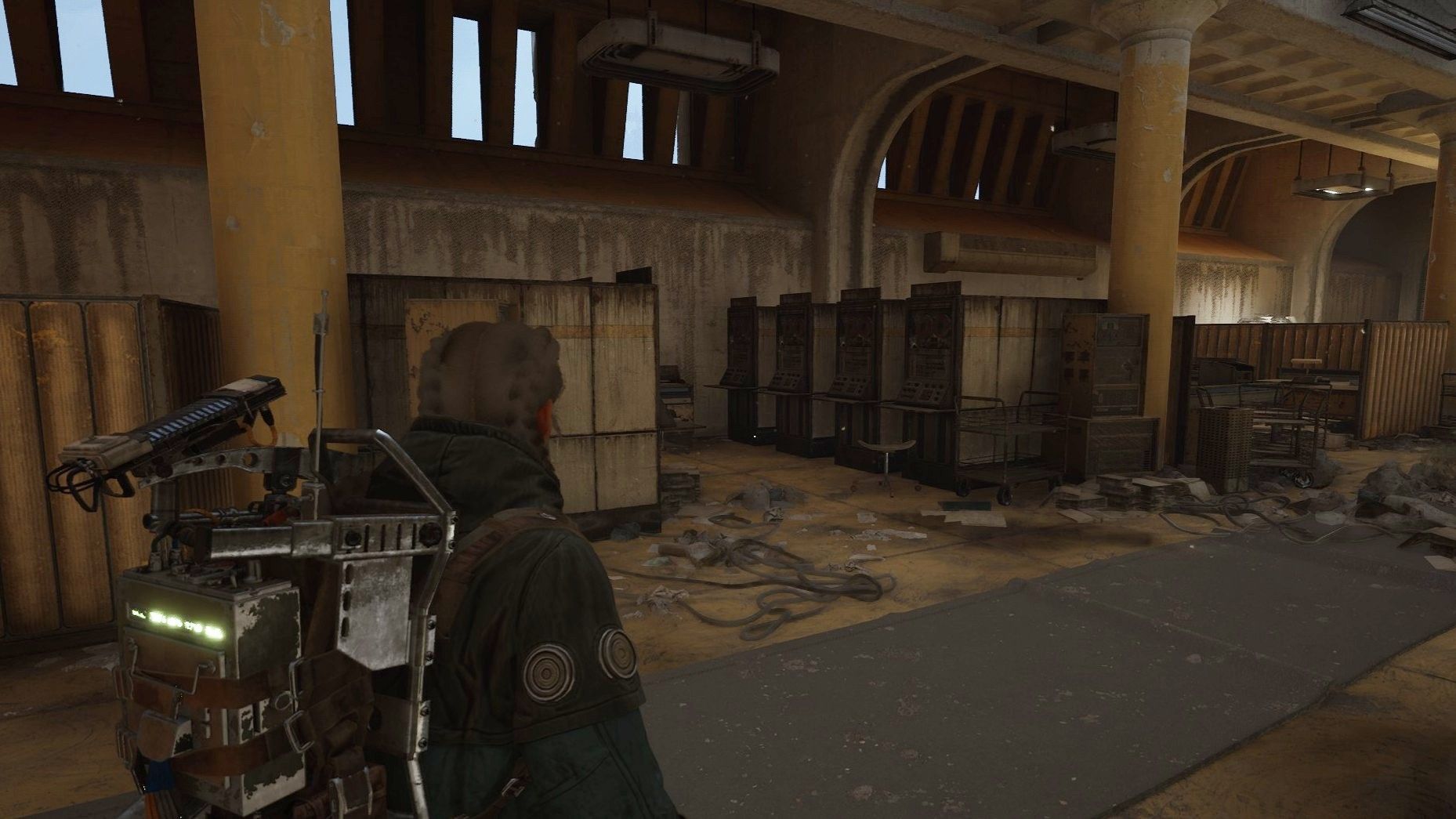The best PC speakers deliver impeccable sound to your gaming experience. Sure the best gaming headsets (opens in new tab) will give you a more intimate immersion, but there’s nothing like blasting everyone in earshot with the best PC speakers. Whether it’s the thrum of your engine in F1 22 (opens in new tab) or the crack of the Kraber unleashing hell in Apex Legends (opens in new tab), the best PC speakers will fill the entire room with your favourite game’s resonant goodness.
Deciding on the best PC speakers isn’t the simplest task. First you need to figure out how much space you have to spare on your desk. It’ll give you an idea of the kind of speaker footprint that’s feasible for your setup, or whether you need to get tidying in anticipation. If you have the space under your desk then you should go for the typical 2.1, left/right speaker setup with a sub-woofer on the floor.
Then there’s PC soundbars, which have made a punchy comeback recently that puts excellent depth of sound and positional audio on your desk, but stays neatly tucked under your monitor. Some even come with a sub-woofer to really get the bass going. Even Razer has gotten into the PC soundbar game (opens in new tab).
The best PC speakers aren’t always cheap, but thankfully, I’ve earmarked a couple of decent budget options during my extensive testing. We’re not all loaded. These are my recommendations for loud, reliable PC speakers.
Best PC speakers
I couldn’t recommend any computer speakers any more than these, and that’s because these ended up being my long-time speakers at my desk at home. The G560s not only sound great, but they also look great too. It’s ideal if you want to ditch the gaming headset for a while and play it fast and loose with your volume dial.
Chances are you either love or hate RGB lighting. The PC Gamer office is generally divided on this topic too, but there’s one thing we can agree on: Logitech’s G560 Lightsync feature is anything but gimmicky. If there’s one RGB product I can recommend that will impact your PC gaming experience, this one.
The audio quality and clean-cut design have these speakers stand out among the crowd.
Logitech’s software allows you to choose between two control modes for the speakers. Hardware control ditches the software and uses Bluetooth or AUX input for lighting. You get a gentle rainbow color cycle that acts as an audio visualizer, which flashes and brightens to the music’s beat. The software control allows you to choose between fixed color, color cycle, breathing, audio visualizer, and screen sampler lighting modes.
The screen sampler, however, is where the G560 shines. Like ambient TV backlighting products (opens in new tab), the software takes user-defined screen areas. It extends the colors outwards to create an immersive lighting experience like Philips’ Ambilight tech on TVs. Since a good portion of this effect relies on the rear-facing LEDs, the speakers need to be positioned beside your display with their back against a wall to get the best result. Get it right, though, and the effect is incredible.
Fundamentally, though, the audio quality and clean-cut design have these speakers stand out among the crowd. I love how they sound out of the box, but you can also tweak them within the Logitech G Hub app. There’s a lot of bass on offer, but the tweeters are just as capable of throwing out excellent audio.
Even when set to low volume on your PC, these speakers may struggle to keep the noise down, but I didn’t pick them for calm and quiet gaming. No, we love the Logitech G560’s powerful audio and surprisingly refined RGB lighting. If both of those sound good to you, look no further.
Please read our full Logitech G560 review (opens in new tab).
When you’re out shopping for budget PC speakers below $50, it’s easy to be overwhelmed by choice. It doesn’t help that reliable brands have multiple options in the same price range. The low-end differences can be minimal, but the Creative Pebble Plus speakers stand apart from the competition with their big sound despite the compact size.
With a total power output of 8W, I found that these speakers pump out crisper audio more than competitors using two to three times the power amount. While they won’t produce the loudest sound around, I heard little distortion even with the volume maxed out. The only complaint here is a lack of bass control to complement the convenient volume knob located on the right speaker.
The Pebble Plus speakers may lack some raw oomph, but they make up for it in clarity. This is why we highly recommend these speakers for students and those who move around a lot, as the speakers are small enough to fit on any cramped desk surface. They’re easily the most portable system I tried and performed best in a smaller bedroom or office.
Like any other pair of speakers below $50, the Creative Pebble Plus speakers are easily shamed by a mid-range set. You are missing out on wireless connectivity, and there are lots of fiddly, easily tangled wires to deal with if you’re moving around a lot. However, these speakers are the clear winner for gamers on a tight budget, and for under $50, these get the job done well.
If you don’t want to stretch your budget to the flashier Logitech G560 speaker set, the company’s much more tame Z407 set offers a great alternative for less money. They’re effectively a similar set of two tweeters and a subwoofer but ditch all the gamer stylings and lights of the fancier kit.
The Logitech Z407s pretty much win the award for most deceptively awesome computer speakers around. This 80W speaker system connects via Bluetooth, 3.5mm headphone jack, or micro USB, so you can easily connect to them with your phone, gaming laptop, or PC. Keeping with the wireless theme, I fell in love with the wireless control knob, which let me control my media with satisfying spins.
That’s one of the key benefits over the much cheaper Creative Pebble Plus, but don’t ignore their simple and effective design. The two tweeters come with small stands for your desk, and the subwoofer is compact enough to not take up to much space under your desk.
What was not satisfying was the unusually short 4ft cables, which limit how you can set them up. However, being able to lay the speakers vertically or horizontally is a nice touch. The sound achieved surprisingly balanced audio for a speaker set for only $80—a strong yes for anyone looking to upgrade their current dinky desktop speakers.
Best gaming headset (opens in new tab) | Best gaming monitor (opens in new tab) | Best HDMI cable for gaming (opens in new tab)
Best microphone for streaming (opens in new tab) | Best SSD for gaming (opens in new tab) | Best CPU for gaming (opens in new tab)
The Razer Nommo Chroma is a huge upgrade from your old dinky desk speakers. The large cylindrical speakers look a bit like the engines of the USS Enterprise but provide crisp, clear audio and deep bass. That bass is driven by rear facing bass ports that offer a more booming response on the low-end than your traditional two-tweeter setup might. Though we do miss a dedicated subwoofer with this package.
The RGB ring under the speakers is a really nice touch, and once again it feels like these computer speakers are rather tastefully designed. Perhaps the best bit of the Nommo Chroma design is that one speaker offers volume and bass knobs, which really help keep the noise down at night if you don’t want to wake up your bedfellows. The bass can’t crank up as high as some on this list, but at least the automatic gain control keeps it distortion-free for the most part.
At $150, Razer’s Nommo Chroma directly competes with several other options on this list. They may not match the sound quality and feature set of the Logitech G560, but the Nommo remains a smart choice for PC gamers who want a pair of great-sounding speakers without the hassle of moving around a sub-woofer. I’d guess that’s mostly people that plan to move around a whole bunch and want something simple, otherwise the Logitech Z407 is a less flashy but more full-featured option.
It’s been a while since we had a soundbar on this list. Mainly because many soundbars out there are tuned and made for TVs and not PC gaming. Often, the soundbar is too big for your desk or too small, and the sound lacks any oomph. However, that’s not the case here, and the Sound Blaster Katana V2 earns a top spot among computer speakers during our time testing it.
The Sound Blaster Katana V2 is a significant upgrade from last year’s model with a sleeker look and, more importantly, better-sounding tweeters and subwoofer. They’re well placed to face your ears while gaming at a desk and pretty powerful. The subwoofer’s 5.25-inch drivers provide the V2 that little kick in the butt you want when you playing shooters and still have a decent enough soundscape for listening to music. Thanks to its many connectivity options, it can also be plugged into pretty much anything you own.
You are sorely mistaken if you thought this soundbar would miss out on RGB lights. The Katana V2 has bright RGB lighting that accents the bar’s underside and adds a little flair. Though this is quite a large unit for any desk, it might be a tight fit if you don’t have much room to spare for the near 24-inch soundbar.
The downside to the Katana V2 is the hefty $350 price tag, which makes it more expensive than most gaming soundbars you can buy right now. Another problem was setting up premium features like SXFI, and Battle mode has to be set up through a cumbersome app. Some nagging odd Bluetooth connectivity issues drove me a bit mad. Weirdly enough, the fix was cycling through different inputs every time.
The Sound Blaster Katana V2 is a great soundbar. It’s small enough to sit comfortably on a decent-sized desk without taking it over and loud enough to easily be featured as your living room sound system (thanks to its subwoofer).
At a glance, it’s easy to mistake the GP9 as just a standard gaming soundbar. It’s way more than that. For starters, one of its many tricks is that the GP9 can act as a wireless speaker with around 5 hours of battery life. So this means you can drag this small speaker right to the living room and give your TV a sound boost (assuming it’s Bluetooth) or connect your phone and enjoy some tunes outside.
The tiny three-pound, 15-inch speaker, does a fantastic job of producing virtual 3D surround sound using its FPS mode setting. If it is late and you can’t blast audio, the speaker will output 7.1 virtual surround sound to any headset you plug into it with a 3.5mm headphone jack. It plays nice with multiple devices and consoles, and an easy-to-understand smartphone app does all your customizations like RGB lighting and EQ options.
Another feature you won’t find in other entries on the list is that this Bluetooth speaker has a built-in mic for voice chat. Between work calls and Discord chatting, my voice was clear and sounded good. If you’re someone who hates wearing headsets all day, it’s a nice feature.
However, I did find myself having some difficulties trying to parse between voice chat and the sounds of gunfire and zombie death gargles during more hectic sessions of Back 4 Blood. When things get wild, it’s hard to hear your teammates let alone try to have a conversation with them without feeling like you need to scream to be heard despite its in-game sound-canceling working its best.
The GP9 pretty much does everything and then some, which would explain the super-high $499 price point. But if you are looking for an incredibly versatile gaming speaker that sounds incredible and can do it all. The built-in microphone is nice, but I don’t see it replacing a headset/microphone combo for team games that require a little more coordination.
The reason we like the MR1 isn’t that they are powerful compact Bluetooth speakers, but they are maybe hands-down one of the best-looking bookshelf speakers we’ve tested. Something about the walnut finish and gray fabric grill screams classy.
It’s not always about looks, though, and the MR1s doesn’t disappoint in the sound department. They deliver mighty powerful audio and hit you with some strong bass without needing a subwoofer (though you can plug one in).
While the MR1 is hands down one of the best pairs of computer speakers we’ve gotten to mess with, they aren’t gaming speakers. There are no custom EQs or preset game modes though I’d argue that these punchy speakers already do a great job and don’t need to be tweaked. Out of the box, these Ruarks make listening to music an absolute joy and turn chaotic action games like Back 4 Blood into near cinematic experiences.
Though, I was bummed to see no USB as a supported connection. This limits you to Bluetooth, optical, and 3.5mm connections, which isn’t the end of the world, but if you want to plug in a PS5, you have to do it through 3.5mm from the Dualsense controller. Not the most elegant solution.
The Ruark MR1 Bluetooth speakers’ superior sound quality and design make it a fantastic choice for anyone looking to jazz up their workspace despite a lack of gaming features. But honestly, you won’t care about any of that after ten minutes of listening to these speakers in action.
The best computer speakers FAQ
Do I need a 2.1, 5.1, or 7.1 setup?
You’ll mostly find 2.1 setups for the PC market covering just left/right channels and a subwoofer—perhaps more often than that, even devoid of a subwoofer for a 2.0 setup. That’s mainly because that fits the bill for a desktop and monitor, with the speakers in front of the user for decent stereo sound.
Living room speaker setups and home cinema systems will take that a little further, often offering at least five surrounding speakers in most cases. You could hook such a system up to your PC and find decent support for such a configuration, but we’re hesitant to recommend such a setup due to the sheer number of wires involved around a single desk. It doesn’t bear thinking about.
Some companies will tout virtual 5.1 to make up for the lack of physical speakers, often at the expense of sound quality, including Windows’ Sonic function. Don’t forget many games use clever 3D audio techniques to generate positional game audio with great accuracy, so you may find you don’t need much of a helping hand.
How do we test computer speakers?
We tested each set of speakers in-game for several hours through a wide range of games with rich soundtracks and sounds, including Doom Eternal, Call of Duty: Warzone, Counter-Strike: Global Offensive, Overwatch, and Hellblade: Senua’s Sacrifice. Afterward, we ran listening tests, which included snippets from the film Jurassic World and various albums in lossless FLAC format, such as Daft Punk’s Random Access Memories and Psychic from Darkside.
One of the most important features to test for was the left/right balance with gaming in mind. To check this in-game, we used the CS: GO Audio Test Chamber workshop project (opens in new tab)by geri43. It’s a simple tool that allows you to reproduce all sorts of in-game sounds, including ladder movements, sniper scopes, gunfire, footsteps, and more. Moving around the map or behind a wall allowed us to manipulate the sounds’ location and test how easily we could identify their direction with the speakers.






